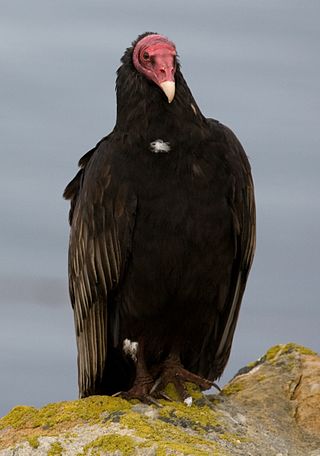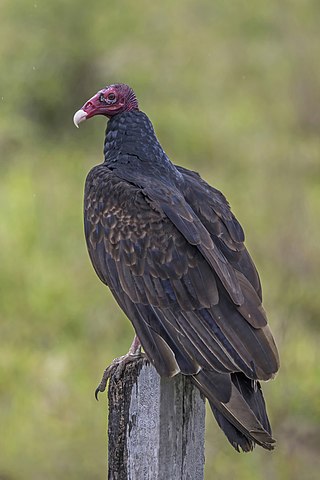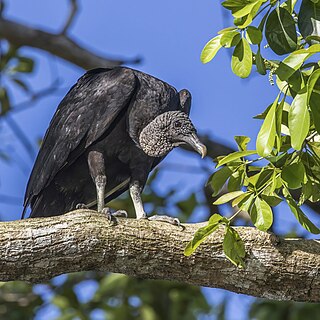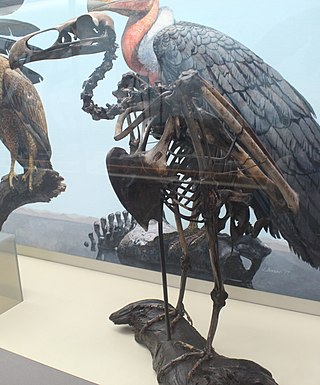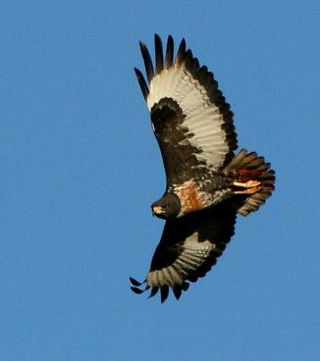| Cathartiformes Temporal range: Eocene to present | |
|---|---|
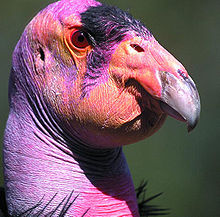 | |
| California condor | |
| Scientific classification | |
| Domain: | Eukaryota |
| Kingdom: | Animalia |
| Phylum: | Chordata |
| Class: | Aves |
| Clade: | Accipitrimorphae |
| Order: | Cathartiformes Coues, 1884 |
| Subtaxa | |
The Cathartiformes /kəˈθɑːrtɪfɔːrmiːz/ order of scavenging birds includes the New World vultures and the now-extinct Teratornithidae. [1] Unlike many Old World Vultures, this group of birds lack talons and musculature in their feet suitable to seize prey. In the past, they were considered to be a sister group to the storks of the order Ciconiiformes based on DNA–DNA hybridization and morphology. [2] [3] However, a 2021 analysis of mitochondrial genes suggested a stronger phylogenetic relationship between Cathartiformes and subfamilies of Accipitriformes. [4]
Cathartiformes, also known as New World vultures, possess unique adaptations in their plumulaceous feathers that prevent the accumulation of bacteria and fungal spores, allowing them to feed on carrion without getting sick. These feather adaptations include a lack of aftershaft, a flattened shape, and a porous structure that allows air to flow through, preventing the retention of moisture and bacteria. Their feathers lack the interlocking hooks found in other bird feathers, making them more flexible and allowing for a greater degree of movement. This flexibility may aid in their ability to maintain body temperature while soaring at high altitudes and navigating through turbulent air currents. Additionally, the presence of feather pulp and melanin pigment in these feathers may contribute to their durability and resistance to wear and tear. These feather characteristics are distinct to Cathartiformes and likely play an important role in their unique ecological niche as scavengers. Additionally, New World vultures have a highly acidic digestive system that allows them to break down and destroy harmful pathogens in their food, especially if the carcasses have been dead for a while.
Vultures feed off dead carcasses, which are also called carrion. Most New World Vultures are obligate scavengers, which is to say they feed only on animals that are already dead. Vulture presence in an area contributes to efficient removal dead carcasses from an area. When Cathartiformes are chicks, they rely on their parents to bring them food. However, adult Cathartiformes do not have feet suitable to carrying food to their young, so they regurgitate meat as well as bone chips to feed their chicks.
Vultures have very sharp eyesight, and they can spot a three-foot carcass from four miles away at altitudes of up to 3 km (10,000 feet). Likewise, their hearing is impeccable: they can hear a range around 5,000 Hz and a threshold of 20 dB. However, when searching for their food, they do not look for healthy animals to attack; they only go after dead or nearly dead animals. Some of the animals they eat are reptiles, mammals, other birds and fish. They have been known to eat human carcasses.
There are four different types of bird under the Cathartiformes category. There are black vultures that have a large, jet-black body. They live within open habitats but along the edges of forests. They weigh around 1.2 to 2.3 kg. They feed off large carcasses but also hunt for living prey. Next are the turkey vultures. They are large brown-black birds with two-tone colors underneath their wings. Grown vultures have a red head. These vultures are located around North and Central America. These vultures weigh about 1.6 to 2.4 kg and locate their prey by smell or sight but also hunt dead and living animals. Continuing on, we have the lesser yellow-headed vultures that are large yet slender black vultures. These vultures have some yellow coloring on their head and their wingspan go beyond length of their tails. They are commonly found in wetlands on the Caribbean slope of Mexico and Nicaragua and are found within marshes, savannahs, and mangroves. They fly lower to the ground and perch on trees to find their prey. Lastly, we have the Californian condor, which are the largest birds in North America. They are black with white patches under their wings and a narrow white patch on the upper side of the wings. They also have very short and square like tails. These vultures reside with in Baja California's mountains. The condor waits until late hours of the night or early mornings to hunt their prey. They also use thermal to hunt as well. These vultures can consume an entire large carcass.
Within the new world vultures there is a subset of seven main species. This includes black vulture, turkey vulture, lesser yellow-headed vulture, greater yellow-headed vulture, Californian condor, Andean condor, and the king condor. The black vulture [5] or (Coragyps atratus) has a large, jet-black body, short black tail, white primary patches, and whitish legs. The length of their bodies is 59–74 cm, with a wingspan of 141–160 cm and weight of between 1.7 and 2.3 kg. Their behaviors include feeding off large carcasses by following other scavengers to the source of food. Turkey vulture, [5] Cathartes aura (Greek katartes, “purifier”, aura, from Latin aurum, “gold”), can be described as large brownish-black vultures with two-toned colors on the underside of their wings. Grown adults will have a red head. There are three other subspecies of turkey vulture located throughout North and Central America. Their length can be 62–72 cm, wingspan 160–181 cm, and weight 1.6-2.4 kg. Behavior includes locating food by smell and sight. They usually eat carrion, but can sometimes catch fish and attack living creatures. Lesser yellow-headed vultures [5] or Cathartes burrovianus, are large yet slender black vultures. They typically have two-toned wings as well, yet there can be some yellow coloring on their heads. Wingtips go beyond the tip of their tail. Length of 53–65 cm, wingspan 150–165 cm, and weight 0.9-1.6 kg. Common in wetlands of the Caribbean slope of Mexico to Nicaragua, they live within marshes, savannahs and mangroves. They tend to fly lower within open wetland looking for carrion through sight and smell and spend lots of time perched on lower ground. The Californian condor [5] or Gymnogyps californianus is the largest bird/raptor found in North America. They are black with white patches under the wings, and a narrow white patch on the upper side of the wings. Their tails are short and square like. They reside within the Baja California mountains and feed entirely on carrion, especially the larger carcasses. These birds hunt with thermal vision in the late hours of the night to early hours of the morning.



